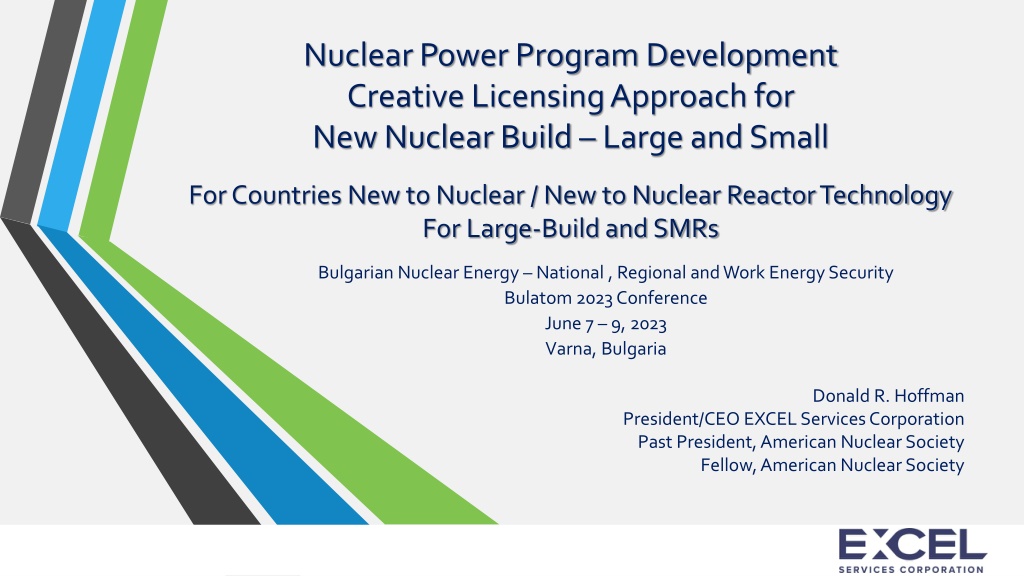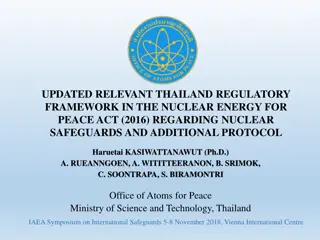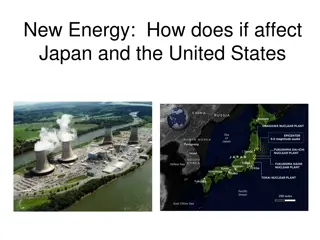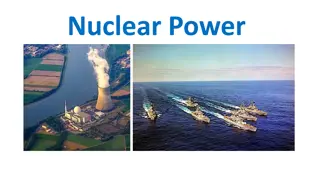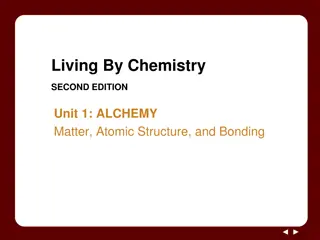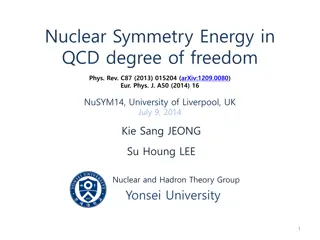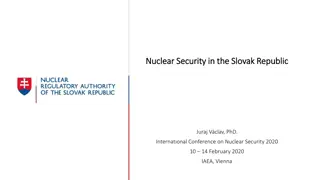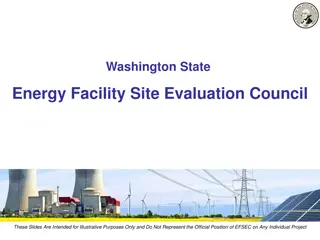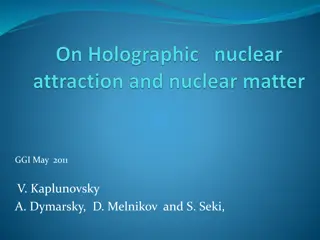Nuclear Power Program Development for Energy Security in New Nuclear Countries
EXCEL Services Corporation, led by Donald R. Hoffman, offers innovative licensing approaches for developing nuclear power programs in countries new to nuclear technology. With over 38 years of experience, EXCEL provides essential support services to ensure the success of new nuclear projects, addressing the global need for clean and secure energy solutions. The company assists in navigating complex nuclear programs, reactor technology selection, and contracting processes to meet energy security and climate change goals.
Download Presentation

Please find below an Image/Link to download the presentation.
The content on the website is provided AS IS for your information and personal use only. It may not be sold, licensed, or shared on other websites without obtaining consent from the author. Download presentation by click this link. If you encounter any issues during the download, it is possible that the publisher has removed the file from their server.
E N D
Presentation Transcript
Nuclear Power Program Development Creative Licensing Approach for New Nuclear Build Large and Small For Countries New to Nuclear / New to Nuclear Reactor Technology For Large-Build and SMRs Bulgarian Nuclear Energy National , Regional and Work Energy Security Bulatom2023 Conference June 7 9, 2023 Varna, Bulgaria Donald R. Hoffman President/CEO EXCEL Services Corporation Past President, American Nuclear Society Fellow, American Nuclear Society
Who IS EXCEL Services Corporation? EXCEL has been providing nuclear support services in the US and 27 countries for over 38 years EXCEL is technology neutral EXCEL has provided support to both one entity and to multiple entities under one contract ( one utility and multiple utilities and Owners Groups of multiple utilities and reactor types) EXCEL is not the reactor vendor or the constructor or the EPC EXCEL is the trusted partner and Technical Services Organization (TSO) of the country to assure your every success 2
Global Situation As we have heard, the World is looking for alternatives to limit carbon generation and decrease global warming while still providing for energy security and national security All countries ideally would like an Energy Policy that provides for energy that is abundant, reliable, secure, affordable and clean. Renewables can contribute but nuclear energy is the clean energy workhorse Countries that have not had nuclear before and even those that have had nuclear in the past are realizing the need for new nuclear now to provide for their energy security, national security and clean energy needs to address climate change. 3
Why Does Your Country/Company Need Support New-Nuclear-Countries have: Limited domestic knowledge of contracting with nuclear reactor technology vendors, Limited domestic knowledge of how to select appropriate nuclear reactor technologies, Limited domestic knowledge of how complex compliant nuclear programs are required to be. Some current Nuclear Countries underestimate how outdated and limited their nuclear programs are. 4
A Typical New Nuclear Country Big Mistake Is to underestimate how much work is really involved: All we need to do is raise the money and sign a contract. So wrong. We can trust this vendor to tell us what we need to do. Incredibly wrong. We can ask the IAEA what we should do. That isn t their function or specialty. 5
Nuclear Program Established Guidelines A lot of people and organizations talk about how to develop a modern nuclear program: The general recommendations from WNA (CORDEL) are excellent but have insufficient detail for implementation. Promises on future documents from IAEA low probability of being sufficient or timely for many. Hopeful suggestions from the European Commission have been issued but fall short. EXCEL has done something tangible, and we are ready to deliver with 5 proprietary documents that assess the fundamental objectives: Awareness who needs to take action. Tasks what they need to do. Schedule in what sequence and on what schedule does it need to be done. Support who is really capable. 6
EXCEL Proprietary Guidance Documents 1. New Nuclear Power Program Development an 8-page overview. 2. Nuclear Power Program Roadmap 50 steps for ministries, regulators and licensees in a logical order. 3. Nuclear Power Contracting the realities of vendor contract negotiations. 4. Repurposing Sites for SMR Construction can we save money? 5. Utilizing Standard Designs and Regulatory Cooperation the Roadmap lists the 50 Whats and this document spells out the how to do it and provides an Implementable Approach for Effective Regulatory Cooperation. Our vast and detailed experience and talents are in these documents. So far, we have them in English, Estonian, Latvian, Lithuanian, Polish, and Ukrainian. Other languages are possible once a contract is in place. 7
Two Important Decisions To have a program that 1) provides for the highest level of safety 2) incorporates global nuclear best practices 3) will save costs 4) will provide for the most efficient and effective means to implement a nuclear program, and 5) provides mechanisms to share experience with others: 1. Pursue only Standard Designs, 2. Establish Regulatory Cooperation in support of those designs. 8
What is a Standard Design? Standard design means a design which is sufficiently detailed and complete to support certification or approval in accordance with subpart B or E of this part, and which is usable for a multiple number of units or at a multiple number of sites without reopening or repeating the review. (U.S. NRC - 10 CFR Part 52) Translation: A standard design has a complete vendor supplied document (5000-9000 pages), That has been reviewed and approved already by an experienced regulator, and Is ready for your country to: Negotiate technology and construction contracts Select a site and obtain approval for it, and Start construction. An NPP cannot be a promise, a dream, or a drawing on a brochure it needs to be real and ready. 9
Reality Can be Scary Current Approved Standard Design Facts Design ABWR (2) ESBWR AP600 (2) AP1000 APR-1400 NPM System 80+ (2) Fact (GEH) (GEH) (W) (W) (KEPCO/KHNP) (NuScale) (ABB-CE) Submitted Sep. 1987 Aug. 2005 June 1992 Mar. 2002 Dec. 2014 Dec. 2016 Dec. 1994 Final Submittal Mar. 1997 April 2014 Aug. 1998 June 2011 Sep. 2018 July 2020 Mar. 1995 NRC Approved May 1997 Sep. 2014 Sep. 1998 Sep. 2011 Sep. 2018 Aug. 2020 May 1997 Start to Finish 9 y 8 m 9 y 1 m 6 y 3 m 9 y 6 m 3 y 8 m 3 y 8 m 2 y 5 m DCD RAIs (3) n/a 4586 n/a n/a n/a 524 n/a # of Revisions 4 10 13 19 3 5 n/a # of Pages 10,495 7782 n/a 6952 12,297 5882 n/a # of NRC Staff involved n/a n/a n/a n/a 162 133 n/a # of Contractor Companies n/a n/a n/a n/a 5 7 n/a [1] The NRC design certifications for U.S. EPR and US-APWR have not been completed and have been suspended at the request of the submitters. [2] This NRC design certification has expired. [3] Requests for Information (RAI) indicate a lack of sufficient information in the submittal to allow review completion and they then require a vendor response and closure prior to approval. [4] n/a - information not publicly available. 10
What is Regulatory Cooperation? This is where the regulator of the nuclear reactor technology of any type works with your domestic regulator to help ensure safe implementation of that nuclear reactor technology. Somewhat similar to Type Certification that allows your country to permit the operation of airplanes in your skies but ever so much more complex. Example: a provision that licenses relating to technical requirements and specifications for reactor designs which have been licensed in the past 10 years by the competent authorities in member states of OECD-NEA, or in states having bilateral agreements with Italy on technical and industrial cooperation in the nuclear sector, will be considered to be valid in Italy after approval by the Nuclear Safety Agency. Act on Energy Companies, A.S. 1195, (Art. 14, 2 i)] The U.S. Nuclear Regulatory Commission offers such cooperation. The IAEA provides documents that provide guidance and some of the steps to be taken and some errors to avoid 11
International Nuclear Regulators Association SMRs are being considered by countries across the globe and are "increasingly the primary focus of several nations", the association said, but the "risks and challenges" associated with such technologies need to be addressed. INRA members recognize the potential safety performance opportunities that SMR technologies could offer and the important role of regulators in ensuring that these technologies are deployed safely, securely and consistent with robust non-proliferation requirements, in countries that wish to adopt them. INRA members whose countries are pursuing new nuclear programs are committed to proactively collaborate on generic reactor design assessments and licensing and support national regulatory reviews in (re)embarking nations with new nuclear ambitions. These INRA members will seek to establish bi-lateral and multi-lateral arrangements to enable the provision of advice and guidance and the sharing of regulatory evaluations in support of their national regulatory reviews, lifecycle expertise and resources, the regulators said. Maximizing the value of collaborative reactor design evaluation requires countries that wish to adopt SMRs to commit to specific SMR technologies on similar timeframes and for vendors to develop their safety analysis and reactor designs to a level suitable for regulatory assessment. Those INRA members commit to undertake risk informed, proportionate and well targeted evaluations, and to dedicate the resource required to deliver at pace when technology decisions are taken. 12
International Nuclear Regulators Association Cont. Standard reactor designs will facilitate efficient regulatory reviews, the regulators said, although further work will be required to address local factors such as siting and environmental issues. These will remain the responsibility of the national regulatory body, alongside the ultimate decision on the acceptability for deployment of a reactor design in its sovereign state. INRA expressed its support for the IAEA's Nuclear Harmonization and Standards Initiative, saying its members "recognize the value of an international, coherent framework for information sharing, while noting the potential challenges and practical hurdles facing timely pursuit of an international pre-licensing process. Furthermore, INRA members consider that independent, national regulatory reviews should not be replaced by an international approach." In support of a more global approach to new reactor evaluation, INRA members consider regulatory collaboration through bi/multi-lateral agreements, with appropriate input from industry, the optimum way to maximize the efficiency of evaluations, while emphasizing the crucial role and responsibility of national regulators to guarantee, through the licensing process and continued regulatory supervision, the highest standards of nuclear safety, security and non-proliferation when considering new designs such as SMRs and advanced nuclear technologies. INRA members are ready to support a collaborative approach for the regulatory assessments of SMR technologies in the most efficient and effective way. INRA's nine member countries are Canada, France, Germany, Japan, the Republic of Korea, Spain, Sweden, the UK and the USA. 13
Possible Global Nuclear Regulatory Approach The Global Nuclear Community needs to work to ensure all nuclear regulators are provided a suitable mandate of how to fulfill their mission to provide for the safety of the public and the environment. Each country has the sovereign right to regulate and to provide their mission of safety Differences in a regulatory approach or interpretation of regulatory requirement can lead to regulatory uncertainty CORDEL and other groups have been adding this topic for almost 16 years IAEA has established the Nuclear Harmonization and Standardization Initiative (NHSI) to address this topic The US NRC and CNSC are currently reviewing BWR X300 and Xe-100 in a cooperative fashion How will the other global regulators be able to use the results of the cooperative reviews of BWRX300 and/or Xe-100 or even already reviewed and approved NuScale or any future SMRs/ARs designs regulatory review? EXCEL has developed an Approach based on extensive regulatory experience in the US and around the Globe in licensing approaches that have been utilized leveraging the successes and failures of each of them 14
Global Nuclear Regulatory Approach Foundational Points Highest level of safety paramount Sovereign right of each country recognized Approach reviewed, commented on and agreed to by all affected global nuclear regulatory authorities to the extent practical Leverages the regulatory initiatives and the experiences and lessons learned ( IAEA, NEA, WENRA, MDEP, INRA) Leverages licensing/design certification in the country of origin and/or other country(s) Guidance document tool for regulatory authorities Living document updated periodically Continuous feedback/learning from application in all and every country(s) 15
Nuclear Power Program RoadMap Who Does the [50] Tasks? There are 3 main domestic participants: The Leading Ministry they have 15 tasks, The Nuclear Regulator they have 17 tasks, The Operating Utility (Licensee) they have 18 tasks; for some reason licensees always seem to think that all they must do is raise money. Not true. The tasks for these 3 go in 2 directions (down, and then back up) as decision are made and new services are required. For each of the following tasks the Roadmap provides the rationale, background, integration with other tasks, and historical perspectives that one should expect and receive from a TSO. 16
Nuclear Power Program RoadMap The Leading Ministry Shall: Establish top level requirements (safety, standard design, regulatory cooperation [2]), Establish and fund a regulatory agency [4], Obtain a qualified technical support organization (TSO) [5], Establish language requirements [10], Establish framework for Regulatory Cooperation [35], and And 10 more. 17
Nuclear Power Program RoadMap The Nuclear Regulator Shall: Establish a regulatory engagement strategy [14], Inform Licensees regarding Ministry requirements regarding standardization [16], Propose safety, personnel exposure, quality assurance, standardization, reliability, and records management requirements [13], Ensure that the domestic nuclear regulatory system and laws will function with the cooperating regulator [29], and And 13 more. 18
Nuclear Power Program RoadMap The Licensee Shall: Consider only technologies that comply with Ministry directives [20] Perform a due diligence review of a selected vendor to ensure compliance with quality requirements and usage requirements [21] Inform the regulator of any design selections so that regulatory cooperation can be engaged for that design [26] Establish their quality program and ensure it matches regulator requirements and vendor capabilities [27] Obtain TSO services for site evaluation [48] and contracting [43], and And 12 more 19
Contracting Support from a TSO New-Nuclear-Countries are completely unprepared for contract negotiations with reactor vendors and construction firms. The EXCEL guidance document on contracting identifies 22 specific types of contracts that the New-Nuclear-Country would need to consummate. U.S. licensees have 4796 reactor-years of operation and of combined experience in negotiating such contracts. New-Nuclear-Countries have zero reactor-years of such experience and lawyers can t help them. It isn t legal advice you need - it is practical knowledge of some things that you want to have happen and other things you want to prevent happening. 20
Site Repurposing Document Repurposing Fossil Fueled Sites It sounds logical and forward thinking, but: What if that old crane has insufficient lift capacity? What if the old station transformer has an incompatible voltage requirement? What if the site has soil pollution making it unusable? It may cost more to reuse a site than to start with a green field. Don t assume anything and that includes thinking that your domestic industry has the knowledge to make the site investigation. Find a knowledgeable TSO to partner with. This and more is discussed in the EXCEL Site Repurposing Document. 21
Even if a New-Nuclear-Country Already Knew What to Do How to do it is not obvious. Utilizing Standard Designs and Regulatory Cooperation is the 5th EXCEL document, and it has a 55-page workplan for navigating the important aspects of the design review and construction application review. This has never been articulated in any of the other guidance documents WNA CORDEL (CORDEL provides an excellent overview of issues but no details) EU Canada IAEA INRA Our strong opinion is that no New-Nuclear-Country can accomplish what is needed without support from a TSO intimately familiar with the nuclear reactor technology they select. 22
Utilizing Standard Designs and Regulatory Cooperation Identifies the applicable international agreements and how to ensure their incorporation. Focuses especially on U.S. agreements since the only standard designs currently available are U.S. NRC approved. Identifies legalities that need to be observed for New-Nuclear-Countries domestically. Identifies how to utilize regulatory approvals from another country the U.S. example is used and is currently the only applicable model for this. Details how to build the Licensee construction application in the New-Nuclear- Country. This model utilizes real world experience from experienced practitioners who have broad experience with U.S. NRC and multiple other global regulators. 23
New-Nuclear-Countries Need the Complete Package EXCEL has long been a great nuclear corporate citizen and a strong supporter of our global industry EXCEL believes that the safe , efficient and effective operation of our nuclear power plants is a main element for our nuclear industry to be successful for the long term The 5 EXCEL guidance documents are a solution An experienced TSO intimately familiar with the nuclear reactor technology is also needed to interpret the tasks and assure they are implemented efficiently Whatever you do remember you are the part of the larger global nuclear industry and how well you do will reflect not only on you but also on all of us The existing global nuclear community has your back and wants to support you to assure your success! 24
Questions? Email: Donald.Hoffman@excelservices.com Telephone: (301) 984-4400 www.excelservices.com 25
